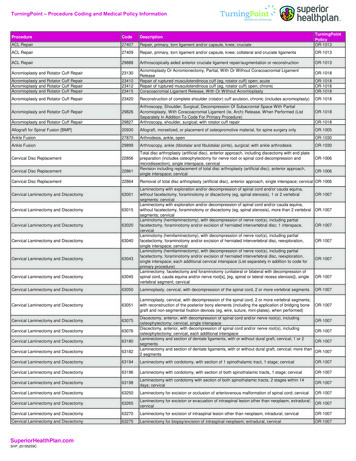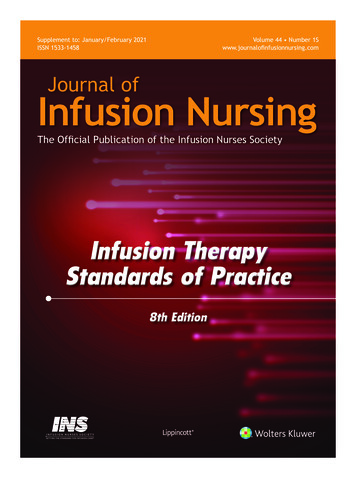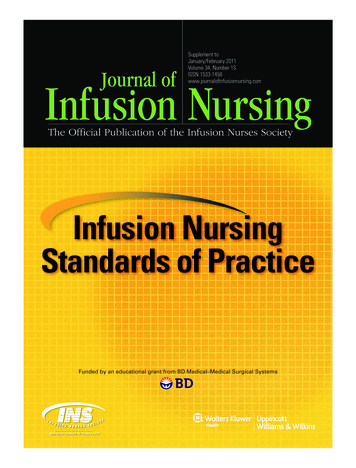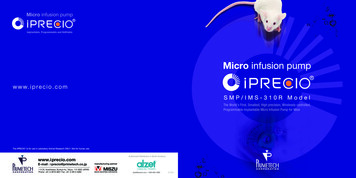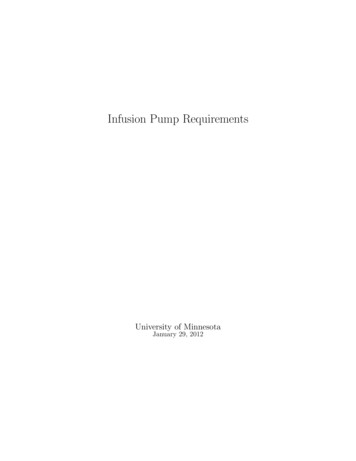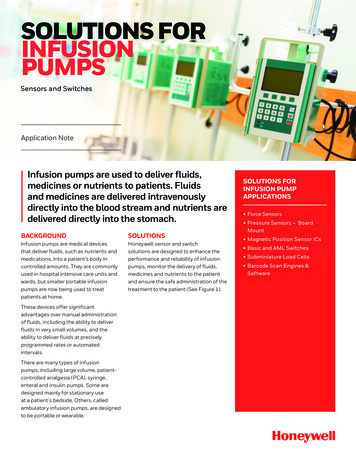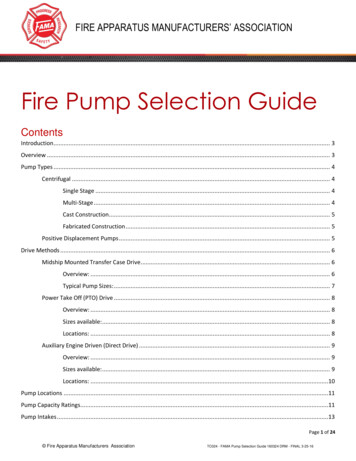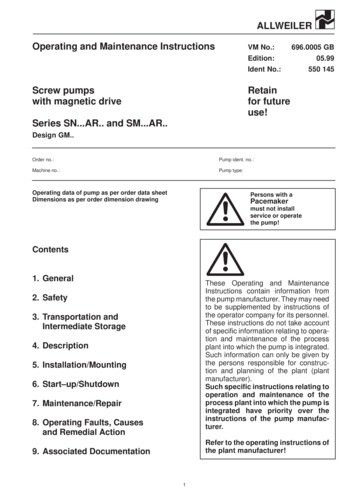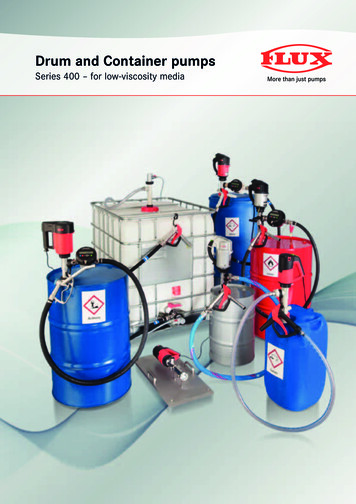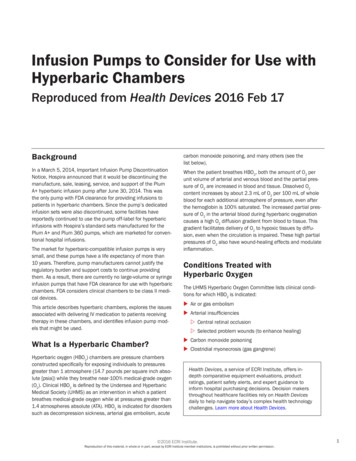
Transcription
Infusion Pumps to Consider for Use withHyperbaric ChambersReproduced from Health Devices 2016 Feb 17BackgroundIn a March 5, 2014, Important Infusion Pump DiscontinuationNotice, Hospira announced that it would be discontinuing themanufacture, sale, leasing, service, and support of the PlumA hyperbaric infusion pump after June 30, 2014. This wasthe only pump with FDA clearance for providing infusions topatients in hyperbaric chambers. Since the pump’s dedicatedinfusion sets were also discontinued, some facilities havereportedly continued to use the pump off-label for hyperbaricinfusions with Hospira’s standard sets manufactured for thePlum A and Plum 360 pumps, which are marketed for conventional hospital infusions.The market for hyperbaric-compatible infusion pumps is verysmall, and these pumps have a life expectancy of more than10 years. Therefore, pump manufacturers cannot justify theregulatory burden and support costs to continue providingthem. As a result, there are currently no large-volume or syringeinfusion pumps that have FDA clearance for use with hyperbaricchambers. FDA considers clinical chambers to be class II medical devices.This article describes hyperbaric chambers, explores the issuesassociated with delivering IV medication to patients receivingtherapy in these chambers, and identifies infusion pump models that might be used.carbon monoxide poisoning, and many others (see thelist below).When the patient breathes HBO2, both the amount of O2 perunit volume of arterial and venous blood and the partial pressure of O2 are increased in blood and tissue. Dissolved O2content increases by about 2.3 mL of O2 per 100 mL of wholeblood for each additional atmosphere of pressure, even afterthe hemoglobin is 100% saturated. The increased partial pressure of O2 in the arterial blood during hyperbaric oxygenationcauses a high O2 diffusion gradient from blood to tissue. Thisgradient facilitates delivery of O2 to hypoxic tissues by diffusion, even when the circulation is impaired. These high partialpressures of O2 also have wound-healing effects and modulateinflammation.Conditions Treated withHyperbaric OxygenThe UHMS Hyperbaric Oxygen Committee lists clinical conditions for which HBO2 is indicated:XXAir or gas embolismXXArterial insufficienciesZZCentral retinal occlusionZZSelected problem wounds (to enhance healing)XXCarbon monoxide poisoningWhat Is a Hyperbaric Chamber?XXClostridial myonecrosis (gas gangrene)Hyperbaric oxygen (HBO2) chambers are pressure chambersconstructed specifically for exposing individuals to pressuresgreater than 1 atmosphere (14.7 pounds per square inch absolute [psia]) while they breathe near-100% medical-grade oxygen(O2). Clinical HBO2 is defined by the Undersea and HyperbaricMedical Society (UHMS) as an intervention in which a patientbreathes medical-grade oxygen while at pressures greater than1.4 atmospheres absolute (ATA). HBO2 is indicated for disorderssuch as decompression sickness, arterial gas embolism, acuteHealth Devices, a service of ECRI Institute, offers indepth comparative equipment evaluations, productratings, patient safety alerts, and expert guidance toinform hospital purchasing decisions. Decision makersthroughout healthcare facilities rely on Health Devicesdaily to help navigate today’s complex health technologychallenges. Learn more about Health Devices. 2016 ECRI Institute.Reproduction of this material, in whole or in part, except by ECRI Institute member institutions, is prohibited without prior written permission.1
XXCompromised grafts and flapsMultiplaceXXCrush injuries and skeletal muscle-compartment syndromesMultiplace hyperbaric chambers can accommodate more thanone patient and medical staff member at a time. Medical equipment that has been through a comprehensive risk assessmentand evaluation may remain inside the chamber to addresspatients’ needs during treatment. Multiplace chambers requirea large amount of space and a significant capital investment.XXDecompression sicknessXXDelayed radiation injuries (soft-tissue and bony necrosis)XXIdiopathic sudden hearing lossXXIntracranial abscessMultiplace chambers are designed to be pressurized with air;maximum operating pressure is 6.8 ATA. If needed, O2 is delivered to the patient via an O2 delivery device, such as a mask,hood, or ventilator.XXNecrotizing soft-tissue infectionsXXRefractory osteomyelitisXXSevere anemiaXXThermal burnsMost treatments for decompression sickness, carbon monoxidepoisoning, and arterial gas embolisms are performed at 3 ATA,whereas most wound care HBO2 pressures are at 2 to 2.4 ATA.Types of Hyperbaric ChambersMonoplaceMonoplace hyperbaric chambers usually consist of a horizontalcylinder made of metal or acrylic, with a metal hatch at oneend. A single patient can recline, sit, or lie within the chamber.Through-hull access ports provide for patient support, such aselectrical connections for patient monitoring and delivery of IVfluids. Electrical signals in monoplace chambers are limited topatient physiologic leads and communications wiring. Viewportsin metal chambers allow observation inside the chamber.Maximum operating pressure of monoplace chambers is 3 ATA.Medical-grade oxygen is commonly used to pressurize thechamber; therefore, no O2 breathing device is necessary. Somemonoplace chambers are pressurized with air; in these chambers, a mask or hood must be used for the patient to receiveHBO2. At specialized centers, intubated patients can be treatedin monoplace chambers. It is accepted practice for chamberspressurized with oxygen to have a mask or mouthpiece thatprovides breathing air to the patient. Some treatment protocolscall for intermittent air breathing interspersed during HBO2 toreduce the risk of oxygen toxicity.2Operating ProcedureFor both monoplace and multiplace chambers, after placing thepatient in the chamber, the chamber operator closes and sealsthe hatch, then pressurizes the chamber with air or oxygen.Depending on how quickly the patient can equalize middle-earpressure, this process takes 4 to 10 minutes or longer. Thepatient remains in the chamber at a pressure and for a durationdetermined by the treatment protocol and may undergo HBO2 ina single session or repeated sessions, depending on the condition being treated.Use of Infusion Pumps withHyperbaric Chambers—Key IssuesAlthough clinical HBO2 was first used primarily at major medical centers, it is now also performed at many smaller facilities,including non-hospital-based facilities. There are approximately4,800 hyperbaric chambers in the United States, of whichapproximately 140 are multiplace chambers.Very few patients require an IV infusion while receiving hyperbaric therapy, which typically lasts 1.5 to 2 hours, although theneed does arise at times:XXAcute patients (e.g., patients with carbon monoxide poisoning, patients just out of surgery receiving HBO2 treatment ofa compromised flap) often need IV therapy during HBO2. 2016 ECRI Institute.Reproduction of this material, in whole or in part, except by ECRI Institute member institutions, is prohibited without prior written permission.
XXCritically ill patients may need one or more infusions duringHBO2, such as norepinephrine, vasopressin, or insulin.XXSome routine patients may be receiving a continuous infusion of an antibiotic that needs to be continued during HBO2.Below we discuss the key issues associated with use of infusionpumps for patients in hyperbaric chambers.Monoplace chamber infusions. For IV infusions delivered topatients in monoplace chambers, the infusion pump is locatedadjacent to the chamber (see the photo on this page). Theinfusion pump administration set is connected to a specializedfitting in a port in the chamber hatch, allowing a seal. Inside thechamber, tubing from the specialized fitting is connected to thepatient’s IV catheter. The infusion pump’s occlusion pressure isset to maximum. In order to deliver the IV solution into the pressurized environment, the pump must be able to generate 30 psior more without alarming and stopping the infusion. An infusionset connector assembly is also required. We are aware of twosuch assemblies:section 14.2.8.3.17.6, “Cord-Connected Devices,” would applyto infusion pumps in a multiplace chamber with electricalreceptacles, although infusion pumps are typically operated onbattery power. Also, the infusion pump needs to be able to operate normally at increased pressure.Fire risks. A clinical hyperbaric chamber combines the use of apressurized atmosphere with the use of oxygen, which createsan increased risk of fire. NFPA requires that chambers be electrically grounded; additionally, if the atmosphere contains morethan 23.5% O2 by volume, patients also must be electricallygrounded. A fire-suppression system is required for multiplacechambers. NFPA classifies multiplace and monoplace chambersas Class A and Class B chambers, respectively. NFPA 99 section14.3.2.4 specifies that equipment used in the chamber be lubricated with oxygen-compatible material, if lubrication is required.1. Argon Medical Devices disposable hyperbaric IV extensionset (PN: 041600503A)2. Sechrist Industries reusable stainless steel pass-through(PN: HB703)Multiplace chamber infusions. Multiplace chambers arelarge enough to permit placement of an infusion pump insidethe chamber (see the photo on page 4). For a pump that isdeployed in this way, there is no need to change the occlusionpressure setting. Chapter 14 of the National Fire ProtectionAssociation’s NFPA 99, Health Care Facilities Code, 2015 edition, applies to hyperbaric facilities. Requirements related tousing infusion pumps in multiplace chambers are specified insection 14.2.8.3.17, “Portable Patient Care—Related ElectricalAppliances,” including 14.2.8.3.17.5, “Battery-OperatedDevices.” In particular, batteries shall not be damaged by themaximum chamber pressure at which they will be used andthey shall not be charged while located in the chamber. Lithiumand lithium-ion batteries are prohibited unless the product islisted for use in hyperbaric conditions. The requirements inA Zyno Medical Z-800F pump infusing to a patient in a monoplace chamber.The pump’s infusion set is attached to the proximal connector of a hyperbaricextension set that is sealed in the wall of the chamber (see arrow). Pumps mustbe able to generate 30 psi or more to deliver fluid into a pressurized chamber.Although it is depicted being used for a hyperbaric infusion, this model hasnot been FDA-cleared for such use. (Photo courtesy of Lindell Weaver, MD,Intermountain Healthcare, Salt Lake City, Utah) 2016 ECRI Institute.Reproduction of this material, in whole or in part, except by ECRI Institute member institutions, is prohibited without prior written permission.3
Equipment safety evaluation. NFPA 99 requires the safetydirector of the hyperbaric facility to be responsible for all equipment used in the hyperbaric environment. A comprehensiveevaluation and risk assessment of any portable medical equipment must be completed and documented under varioushyperbaric conditions to ensure that the equipment is safe foruse with or within a chamber.Infusion Pumps That May BeConsidered for Use withHyperbaric ChambersListed alphabetically below are the models that appear in studies of pump operation during use within, and/or during deliveryinto, pressurized hyperbaric chambers. (See the bibliographyfor the list of studies.) Also included are pumps whose specifications indicate that they could meet the requirements forhyperbaric use.These studies of standard infusion pumps (some of which areno longer commercially available) demonstrate the extent ofvariations in performance when operating during hyperbaricconditions. Hyperbaric facility staff should be guided by thesestudies in testing any infusion pump that they want to use withtheir chamber(s) to ensure proper operation and to anticipatepossible deviations in flow accuracy.Large-Volume PumpsFor Use with Monoplace Chambers1. Baxter Flo-Gard 6201—This pump is discontinued but isreadily available; it operates with Baxter s-series infusionsets. Hyperbaric Clearinghouse supplies a modified version of the Flo-Gard 6201 pumps for use with monoplacechambers.2. CME Body Guard 323 Color Vision—This pump has notbeen FDA-cleared to be marketed in the United Statesfor any clinical application.3. Zyno Medical Corp. Z-800F—See our Evaluation of thispump (available to members of specific ECRI Instituteprograms).An Alaris MedSystem III pump set up for use on battery power in a multiplace chamber. Although it is depicted being used for a hyperbaric infusion,this model has not been FDA-cleared for such use. (Photo courtesy ofLindell Weaver, MD, Intermountain Healthcare, Salt Lake City, Utah)4For Use in Multiplace Chambers1. CareFusion (formerly Alaris) MedSystem III—In addition toCareFusion, infusion sets are available from Medline andMoore Medical. 2016 ECRI Institute.Reproduction of this material, in whole or in part, except by ECRI Institute member institutions, is prohibited without prior written permission.
2. CareFusion Alaris System 8015 Large-Volume Pump—See our Evaluation of this pump. The service manualstates that the Alaris System (with the exclusion of theEtCO2 module) “has been verified to operate with nomalfunction alarms due to the hyperbaric chamber environment or unintentional key presses when used in ahyperbaric chamber”; it is not certified for use in oxygenenriched environments.3. Imed/Alaris Gemini PC1 and PC2—These pump modelsare discontinued but readily available; they operate withCareFusion infusion sets marketed for the Alaris System8015 LVP module.4. Medical Technology Products MTP.Syringe Pumps1. Atom Medical Corp. 235—This pump is discontinued andwas not FDA-cleared to be marketed in the United Statesfor any clinical application.BibliographyBell J, Weaver LK, Deru K. Performance of the Hospira PlumA (HB) hyperbaric pump. Undersea Hyperb Med 2014May-Jun;41(3):235-43.Bell J, Weaver LK, Deru K. Performance of three large-volumeinfusion pumps with the monoplace hyperbaric chamber.Undersea Hyperb Med 2016 Jan-Feb;43(1):9-19.Chhoeu AH, Conard JL, Freiberger JJ, et al. Evaluating Alaris IVinfusion system for functional accuracy and safety up to 6 ATA.Undersea Hyperb Med 2006 Sep-Oct;33(5):347-8.Dohgomori H, Arikawa K, Kanmura Y. Accuracy of infusion pumpduring hyperbaric oxygen therapy. Undersea Hyperb Med 2003May-Jun;30(3):216-7.2. CareFusion Alaris System 8110 Syringe Pump—See ourEvaluation of this pump. The service manual states thatthe Alaris System (with the exclusion of the EtCO2 module)“has been verified to operate with no malfunction alarmsdue to the hyperbaric chamber environment or unintentional key presses when used in a hyperbaric chamber”; itis not certified for use in oxygen-enriched environments.3. Fresenius Vial Infusion Technology PILOTE Hyperbaric—Although this pump is specified for operation with bothtypes of hyperbaric chambers, it has not been FDAcleared for marketing in the United States for any clinicalapplication.Pump manufacturer information can be obtained from the ECRIInstitute’s Healthcare Product Comparison System [HPCS]reports for large-volume infusion pumps and syringe infusionpumps. (HPCS is available to members of the Health DevicesGold and SELECTplus programs.)ECRI Institute (Available to members of specific ECRI Instituteprograms):Chambers, hyperbaric. Healthcare Product ComparisonSystem. Available from: baric.aspx.Evaluation: Zyno Medical Z-800F and Z-800WF infusionpumps. Health Devices 2015 May 13. Available es/Evaluation-Zyno-Z-800F-and-Z-800WF.aspx?tab 1.Evaluation: CareFusion Alaris infusion pump. HealthDevices 2015 Jun 3. Available from: aluation-CareFusionAlaris.aspx?tab 1.Evaluation: CareFusion Alaris infusion pump with syringemodule. Health Devices 2014 Jul 16. Available from: ge-Module.aspx. 2016 ECRI Institute.Reproduction of this material, in whole or in part, except by ECRI Institute member institutions, is prohibited without prior written permission.5
Hospira—Plum A hyperbaric infusion pumps: manufacturerdiscontinues sales, service, and support. Health DevicesAlerts 2014 Mar 25. Accession no. A22027. Available login.aspx?Page AlertDisplay&AId 1616732&FL N.National Fire Protection Association (NFPA). Hyperbaric facilities. Chapter 14. In: NFPA 99: Healthcare facilities code. Quincy(MA): NFPA; 2015.Infusion pumps, large-volume. Healthcare ProductComparison System. Available from: -Large-Volume.aspx.Ray D, Weaver LK, Churchill S, et al. Performance of theBaxter Flo-Gard 6201 volumetric infusion pump for monoplace chamber applications. Undersea Hyperb Med 2000Summer;27(2):107-12.Infusion pumps, syringe; drivers, syringe. HealthcareProduct Comparison System. Available from: -Syringe;-Drivers,Syringe.aspx.Hernandez J, Weaver LK, Churchill S. Intravenous infusion pumpperformance under monoplace hyperbaric chamber conditions.Undersea Hyperb Med 2005 Jul-Aug;32(4):312.Kot J. Equipment for multiplace hyperbaric chambers part III:infusion pumps and syringes. Eur J Underw Hyperb Med 2006Jun;7(2):29-31.Lavon H, Shupak A, Tal D, et al. Performance of infusionpumps during hyperbaric conditions. Anesthesiology 2002Apr;96(4):849-54.6Neuman TS, Thom SR. Physiology and medicine of hyperbaricoxygen therapy. 1st ed. Philadelphia: Saunders; 2008.Stanga DF. Evaluation of intravenous therapy devices in thehyperbaric chamber. NEDU TR 03-21. Panama City (FL): NavyExperimental Diving Unit; 2003.Story DA, Houston JJ, Millar IL. Performance of the Atom 235syringe infusion pump under hyperbaric conditions. AnaesthIntensive Care 1998 Apr;26(2):193-5.Weaver LK, Ray D, Haberstock D. Comparison of three intravenous infusion pumps for monoplace hyperbaric chambers.Undersea Hyperb Med 2005 Nov-Dec;32(6):451-6.Wreford-Brown CE, Ross D. Assessment of intravenous infusionpumps under hyperbaric pressure in a multiplace chamber.Undersea Hyperb Med 2003 May-Jun;30(3):261. 2016 ECRI Institute.Reproduction of this material, in whole or in part, except by ECRI Institute member institutions, is prohibited without prior written permission.
In a March 5, 2014, Important Infusion Pump Discontinuation Notice, Hospira announced that it would be discontinuing the manufacture, sale, leasing, service, and support of the Plum A hyperbaric infusion pump after June 30, 2014. This was the only pump with FDA clearance for providing infusions to patients in hyperbaric chambers.
